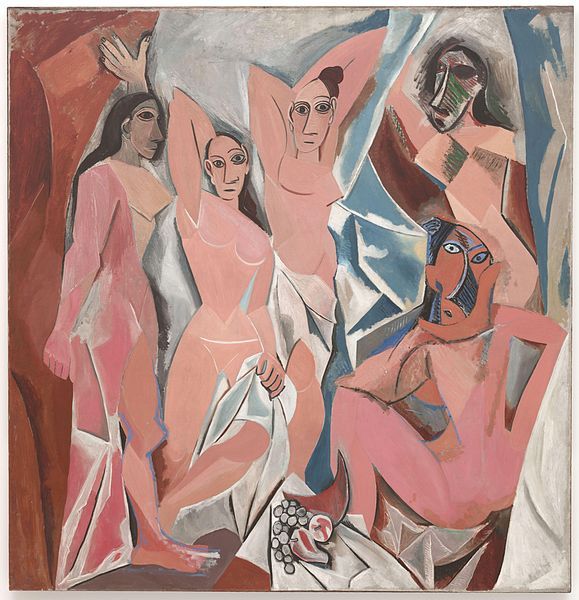Summary of Amedeo Modigliani
A central participant in the École de Paris, Modigliani modernized two of the enduring themes of art history: the portrait and the nude. Characterized by a sense of melancholy, elongated proportions, and mask-like faces influenced by such sources as Constantin Brancusi and African art, Modigliani's portraits are both specific and highly stylized, each uniquely revealing its sitter's inner life, while at the same time unmistakably "Modiglianized," to use the words of one critic. Modigliani's nudes scandalized audiences with their depiction of features such as pubic hair and their frank, unadorned sexuality. The subject of three biographical movies, Modigliani's legacy is inextricably bound up with his tragic and bohemian life: his fragile health, which plagued him since childhood; his perpetual pennilessness; and - most famously - his over-the-top, self-destructive lifestyle, which included sexual debauchery and overuse of drugs and alcohol.
Accomplishments
- Modigliani upended the tradition of the nude. Modern in their candid sensuality, his works in this genre are noticeably devoid of the modesty and mythological subtext present in many earlier depictions of nude figures. Because of these qualities - along with the artist's notorious womanizing - Modigliani's nudes were scandalously received at the time they were created.
- Modigliani's portraiture achieves a unique combination of specificity and generalization. His portraits convey his subjects' personalities, while his trademark stylization and use of recurring motifs - long necks and almond-shaped eyes - lends them uniformity. Modigliani's portraiture also serves as a vital art historic record, comprising a gallery of major figures of the École de Paris circle, to which he belonged following his move to Paris in 1906.
- The work of the Romanian sculptor Constantin Brancusi was perhaps the single most important influence on Modigliani's creative development. Although Modigliani is best known as a painter, he focused on sculpture early on in his career, and, some writers have argued, may have regarded his true calling as that of sculptor. The sculptures Modigliani created in 1909-14, of which twenty-five carvings and one woodcut survive, were highly influential on his work as a painter, helping him arrive at the abstracted and linear vocabulary of his painting.
Important Art by Amedeo Modigliani
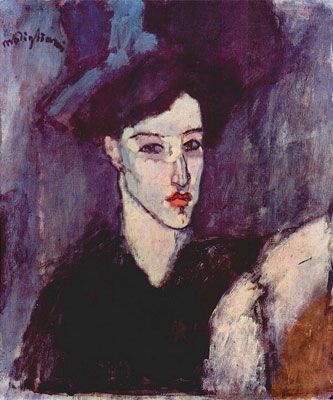
The Jewess
The Jewess was the first painting Modigliani sold after settling in Paris in 1906. It was purchased by his friend and patron, Paul Alexandre, who was so taken with the work that he had Modigliani paint it into the background of three additional commissioned portraits. Although wearing a composed expression, the stark whiteness of the sitter's face contrasts harshly with her dark apparel, giving the composition and inner tension and suggesting strong emotions lying beneath the surface. The painting's melancholic overtones have invited comparison with the work of Picasso's Blue Period. The painting is also one of the few Jewish-themed works by Modigliani, who was of Sephardic Jewish descent and publically embraced his Jewish identity.
Oil on canvas - Re Cove Hakone Museum, Kanagawa

Head
Although inspired by Brancusi's marble work, Modigliani's sculptures were often made from softer, less expensive limestone, as in this work. Head's graceful contours and abstracted features suggest Brancusi's influence, while the elongated proportions - specifically, the swan-like neck - is reminiscent of ancient Egyptian busts, among the non-Western art forms that influenced Modigliani's work. The subject's elongated neck and nose, and slit-like eyes also closely resemble the artist's handling of these features in his portraits and nudes, suggesting the close connection between his work in sculpture and two-dimensional media.
Limestone - Private Collection

Portrait of Pablo Picasso
Althought insecure about his own work, Modigliani had mixed feelings about Picasso. Modigliani was envious of his rival's success, but drawn to his charismatic personality and artistic talent. These competing feelings emerge in this portrait: this ambivalence is suggested in the two-toned face, while the overall gestural, uneven application of paint hints at inner conflict. Yet, the round face and facial features resemble Southeast Asian depictions of Buddha, showing Modigliani's respect for Picasso's wisdom and experience. This is literally spelled out on the lower right side of the painting with the French word savoir ("to know").
Oil on paper mounted on card - Private Collection
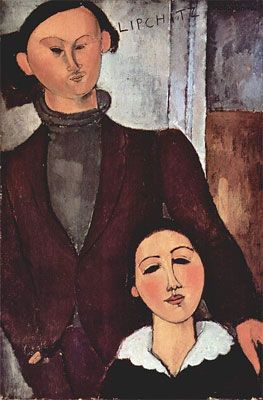
Jacques and Berthe Lipchitz
This double portrait of Jacques Lipchitz and his wife, Berthe, exemplifies Modigliani's talent for eliciting the inner life of his subjects. Although his stylized method of painting presents two mask-like faces, they reveal subtle clues about the personality of each sitter. Berthe has an open, kindly face, conveyed by the brightness of the paint and downward tilting eyes. Jacques, with his small, compressed features sloping inward, appears calculating and suspicious. Wanting to pay his friend Modigliani as much as possible for his work, Jacques Lipchitz insisted on further changes after its completion; as a result, the painting took nearly two weeks to finish.
Oil on canvas - The Art Institute of Chicago
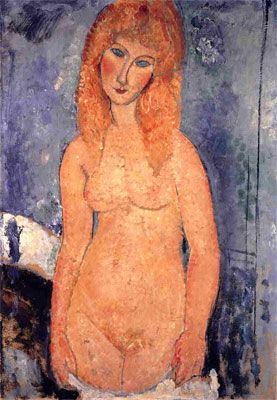
Standing Blonde Nude with Dropped Chemise
Modigliani's nudes are often frank depictions of sensuality that frequently reference the traditional handling of this theme, but without the mythological context of their artistic precursors. The present work, for example, suggests Sandro Botticelli's Birth of Venus - a painting with which Modigliani was undoubtedly familiar from his studies in Florence - through such features as the subject's long blonde hair, tilted head, and the figure's contrapposto. The classic composition, however, is skillfully subverted and heavily modernized. While Botticelli's subject artfully covers her genitals with her flowing locks and smiles placidly, Modigliani's sitter draws attention to this area with her dropped chemise and confronts the viewer with a slight smirk. Such features of the Modigliani painting likely contributed to the uproar generated by the artist's now legendary exhibition at Berthe Weill's gallery in 1917.
Oil on canvas - Private Collection
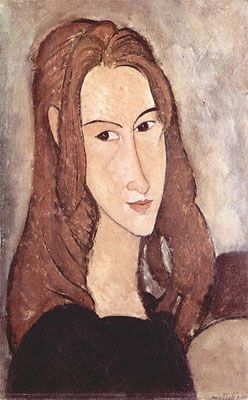
Portrait of Jeanne Hebuterne
When Modigliani entered into a relationship with the nineteen-year-old Jeanne Hebuterne, his close friends hoped that the serious young woman would inspire Modigliani to curb his excesses. Hebuterne, however, loved the artist with a blind adoration that made no demands. Although there were no fundamental changes in his behavior, Modigliani's portraits of his young lover suggest the artist's newfound sense of peace and serenity. Less stylized than those in the artist's earlier works, the sitter's features, especially the sly, sideways gaze, suggest a psychological clarity that communicates Hebuterne's inner character.
Oil on canvas - Private Collection
Biography of Amedeo Modigliani
Childhood
Amedeo, or "Dedo," Modigliani was the youngest of four children born to Jewish parents, Flaminio and Eugenia, in Livorno, Italy, home to a large Jewish community. Shortly before his birth, the family businesses had fallen onto hard times, forcing the Modiglianis to declare bankruptcy. Amedeo's timely arrival may have resulted in the rescue of many valuable heirlooms; according to family legend, soldiers were forced to avoid Eugenia in childbirth as they came to repossess the furniture, in accordance with an old Italian custom that forbade the seizure of any possessions in the bed of a woman in labor.
Eugenia's father and sister, Isaac and Laure Garsin, played a significant role in Amedeo's upbringing. The Garsins were highly educated, introducing Amedeo to literature, poetry, philosophy, and the visual arts at a young age. In 1895, Amedeo contracted the first of several serious illnesses that he battled throughout childhood. While suffering from typhoid, he first told his mother of his wish to be a painter. Although Eugenia preferred an academic education for her son, she later acceded to his wishes, as she recounted in her diary: "On the first of August [1898], he begins drawing lessons, which he has wanted to do for a long time. He thinks he's already a painter." The following year, Amadeo gave up his regular schooling entirely to study with his drawing teacher, Guglielmo Micheli.
Early Training
After being diagnosed with tuberculosis in 1901, Modigliani recuperated in southern Italy with his mother. Visits to the museums in Naples, Rome, Florence, and Venice familiarized him with classical Italian painting and sculpture, fueling his enthusiasm for the fine arts. After their return to Livorno, he convinced his mother to allow him to move to Florence, where he studied figure drawing at the Scuola Libera di Nudo. Possibly inspired by his admiration for Michelangelo, he moved to Pietrasanta in 1903 to devote his time to sculpture, but found his strength insufficient for the strenuous and time-consuming stone-carving process.
In Florence, Modigliani became acquainted with Manuel Ortiz de Zarate, an artist who had worked with the Impressionists. Intrigued by Zarate's descriptions of Paris and the avant-garde, Modigliani decided to pursue his ambitions there, but his mother encouraged him to stay in Florence. Restless for new opportunities, Modigliani moved to Venice and enrolled in the Scuola Libera di Nudo at the Istituto di Belli Arti, which he found overly traditional in its curriculum. He discovered a preference for art-making amid the atmosphere of the local bars and cafés, where he was introduced to illicit substances. Growing increasingly dissatisfied with the art scene in Italy, his mother finally allowed him to move to Paris in 1906.
Mature Period
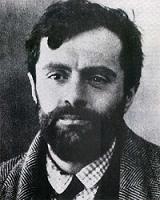
As Modigliani settled into Paris, he enrolled in the Académie Colarossi and spent the first few months visiting area galleries and museums. He was soon absorbed into the Bateau Lavoir circle, which included Juan Gris, Max Jacob, Pablo Picasso, and André Salmon, among other well-known art and literary figures. Searching for an innovative style that could compete with those practiced by the Parisian avant-garde, Modigliani concentrated on painting. Works from this period show a high regard for the Post-Impressionists. Head of a Woman Wearing a Hat (1907) makes use of a curvilinear style that is characteristic of Art Nouveau, but also exhibits the influence of Henri de Toulouse-Lautrec in the tilt of the woman's shoulders and the thoughtful, expressive face, revealing Modigliani's early interest in representing psychological states.
A 1906 exhibition of three paintings at the Laura Wylda Gallery failed to generate any sales or interest in Modigliani's work. He approached galleries door to door, sometimes resorting to trading his art for food or other necessities. Frustration with his lack of success led Modigliani to abuse drugs and alcohol, further exacerbating his health problems. His 1907 meeting with Paul Alexandre, a young physician who became a friend and much-needed patron of his work, gave him a renewed sense of accomplishment and a steady source of work. One of Alexandre's favorite works by the artist was The Jewess (1908), a painting influenced by Paul Cézanne and the German Expressionists. The thickly painted canvas, with its solid shapes and dark colors, contrasts sharply with the delicate outlines of the earlier Head of a Woman. Dominant blue tones lend an air of melancholy to the composition, while the clashing areas of black and white convey strong emotion. Modigliani chose The Jewess and four other pieces for the twenty-fourth Salon des Indépendants, but the work received no attention.
Trying to refocus his attention on sculpture, Modigliani looked to Constantin Brancusi, who he met in 1909 through Alexandre. The simple elegance of Brancusi's simplified forms made a strong impression on Modigliani; the older artist's style began to manifest itself in Modigliani's work, as in the limestone Head (1910-12). In his sculptural oeuvre, Modigliani strove for a purity of form, aided by the use of elements from "primitive" African and Southeast Asian art, embraced at the time by many Parisian avant-garde artists such as Picasso.
Late Years and Death
In 1914, Max Jacob introduced Modigliani to the art dealer Paul Guillaume, who bought several paintings and agreed to promote his work. Modigliani's earnings, however, remained meager, and he continued to offer his drawings door to door. In July, he met the English writer and poet Emily Alice Haigh (known by her pen name Beatrice Hastings), who became his lover and the subject of several paintings. Many of these portraits have an angelic quality that suggests a parallel between Hastings and Dante's own Beatrice - an idea that likely appealed to Modigliani. Hastings attempted to gain exposure for Modigliani's work, but his indulgent lifestyle bred conflict in the relationship. Soon after their separation, he fell seriously ill from malnourishment and alcoholism.
After regaining his strength, Modigliani, unable to meet the physical demands of sculpture, continued to paint portraits. By this time, he had melded the influences of the Parisian avant-garde and arrived at his signature painting style, characterized by elegant linearity and the depiction of stylized, yet expressive figures. The best of these works give subtle glimpses into the personality of the sitter, such as the artist's 1916 portrait of Jacques Lipchitz and his wife Berthe.
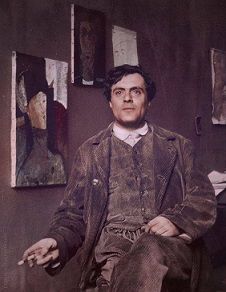
That year, Modigliani began associating with the Polish poet and art dealer Leopold Zborowski, who arranged the artist's first and only solo exhibition in his lifetime, at the Berthe Weill Gallery in December 1917. To entice passersby, Weill installed an attractive nude in the front window. Scandalized, the local police temporarily shut down the exhibition, but the unintended publicity resulted in better sales than usual for the habitually impoverished artist.
In 1917, Modigliani met Jeanne Hebuterne, a young art student from the Académie Colarossi. The two fell in love, and Hebuterne later became his common-law wife. Zborowski, who had committed himself to supporting Modigliani's work, hoped that their relationship would provide both a new source of inspiration for Modigliani's portraiture and a measure of stability for the artist that would help temper Modigliani's dissolute lifestyle. Although his alcohol and drug consumption remained virtually unchanged during their time together, the portraits of Hebuterne reflected the artist's newfound sense of relative tranquility. In 1918, she gave birth to a daughter, named for her mother. New familial responsibilities, combined with his professional obligations to Zborowski, spurred Modigliani to increase productivity despite his fading health. A self-portrait from 1919 suggests a sense of calm and confidence in his work, which afforded him some measure of peace toward the end of his life. Yet, the artist's health ultimately gave way, with Modigliani succumbing to tubercular meningitis the following year.
The Legacy of Amedeo Modigliani
Although his works were not commercially successful during his lifetime, they became increasingly popular after his death. Modigliani is now among the celebrated artists of the twentieth century. While not closely associated with any one particular or formal movement, Modigliani arrived at a signature style that fused aspects of contemporary European artistic developments such as Cubism with non-Western art forms like African masks. His portraits and nudes overturned the conventions of both genres, uniquely combining innovative formal experimentation with probing candor and psychological insight, and earning the admiration of Modigliani's artistic contemporaries such as his close friend and fellow École de Paris artist, the painter Chaim Soutine.
Yet Modigliani's creative legacy remains intertwined with the romantic legend of the quintessential bohemian artist, bound up with a life of excess and Jeanne Hebuterne's tragic suicide the day after Modigliani's death. To date, there are three movies that recount his life and times that all center on this legend, portraying him as a passionate individual with a decadent, self-destructive lifestyle. In addition, at least nine biographies have been written on the artist that address this theme to varying degrees, including one by his daughter, Jeanne Modigliani - aptly titled Modigliani: Man and Myth.
Influences and Connections

-
![Constantin Brâncuși]() Constantin Brâncuși
Constantin Brâncuși ![Paul Alexandre]() Paul Alexandre
Paul Alexandre![Max Jacob]() Max Jacob
Max Jacob
Useful Resources on Amedeo Modigliani
- Modigliani: A Life (2006)Our PickBy Jeffrey Meyers
- Modigliani: A Life (2011)Our PickBy Meryle Secrest
- Modigliani: Man and MythBy Jeanne Modigliani
- Modigliani: The Pure BohemianBy June Rose
- Modigliani: A Biography of Amedeo ModiglianiBy Pierre Sichel
















